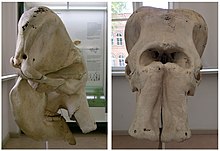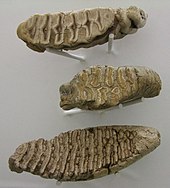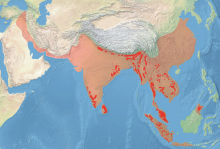Asian elephant
The Asian elephant (Elephas maximus) is a species of the elephant family and the second largest land animal on earth after the African elephant. Like its African cousin, it is distinguished by its trunk, tusks, columnar legs, and overall body size. However, both differ in the size of the ears, the slightly different dorsal line, and numerous individual anatomical features. The range of the Asian elephant includes South Asia, Southeast Asia including parts of the Malay Archipelago, and southern East Asia. However, its former range was much larger. The animals inhabit various forest landscapes and open land areas from sea level to higher mountain ranges.
The way of life of the Asian elephant is well researched through numerous studies, but has not yet been worked out in as much detail as with the African elephant. The social structure shows a complex structure. The closest bonds are between mothers and young. Several of these groups form a herd or family unit of interrelated animals. The individual animals often form short-term partnerships, which, however, have a stable character due to multiple reunions. The hierarchy within the family group is rather flat, a dominant leader cow as in the African elephant plays a subordinate role. The individual herds use action areas, the size of which depends on the respective landscape conditions and food resources. They communicate with each other in various ways, for example with sounds in the low frequency range, with numerous chemical signal transmitters and by touching each other mainly with their trunks. Similar to the African elephant, the Asian elephant also possesses high cognitive abilities, including self-awareness.
The diet includes soft and hard plant foods with regional and seasonal variations. Harder plant foods usually predominate in the rainy season, softer ones in the dry season. The size of the animals means that an individual spends most of its daily activity on feeding. Breeding mostly occurs year-round, but may be limited in more seasonally influenced landscapes. Bulls are characterized by the annual musth, which is accompanied by increased aggressiveness. Rivalry fights may occur during this phase. Cows exhibit a long rutting cycle with a course atypical of mammals. As a rule, a calf is born after about two years of gestation and grows up in the maternal group. For the duration of the rearing, the rutting of the cow is interrupted. The female offspring remains in the family group, the male leaves and goes his own way.
The Asian elephant caused a strong cultural influence in the history of man. The taming possibly goes back to the third millennium BC. The animals were used, among other things, for construction work, in military service or for representative purposes. However, numerous human-animal conflicts occur annually with wild elephants. The first scientific description dates back to 1758. In the course of time, several subspecies have been introduced, but from a genetic point of view they do not exist. Rather, two genetically distinct groups can be distinguished, both sharing almost the entire range. Early fossil records of the Asian elephant date back to the Middle and Upper Pleistocene, but are rare overall. The species' population is considered critically endangered and is in decline, primarily due to landscape destruction and poaching.
Features
Habitus
The Asian elephant is the second largest land mammal on earth today, after the African elephant (Loxodonta africana). Like its African relative, the animals can be easily identified by their trunk, tusks and columnar legs. Head-torso length is about 550 to 640 cm, plus a 120 to 150 cm tail. Male individuals grow much larger than females, with a shoulder height averaging 270 cm and a maximum of 340 cm, and a weight of about 3600 kg and a maximum of 6000 kg. In the latter, shoulder height measurements average 240 cm (maximum over 250 cm) and weight averages 2720 kg (maximum 4160 kg). Most analyses of Asian elephant size values are from animals from India, but these tend to be larger than populations further east. Data are available from the 1940s on single individuals with heights ranging from 323 to 343 cm (the latter value refers to a skeleton). The Asian elephant from the island of Borneo, on the other hand, grows on average about half a metre shorter. In contrast to the African elephant, the back of the Asian elephant is arched or straight, the highest point of the body is found on top of the head and not on the shoulder. The head is compressed, with two prominent humps rising on the forehead. The tip of the trunk has only one finger-like extension instead of two as in the African elephant. Unlike the latter, the ears are much smaller and folded on the upper edge. They grow up to 60 cm high and 55 cm wide and cover an area of about 0.5 m² (related to both sides of the ears). The thickness is only about 1.5 cm. Tusks are usually only developed in bulls. The skin is mostly grey, animals from the eastern part of the range often have a lighter colouring than those from the west. Sometimes there are single pigment-free zones on the trunk and ears, which then appear flesh-coloured. The thickness of the skin varies, it averages 18 mm, but can reach up to 30 mm on the back. Hair is sparsely developed, but denser than in the African elephant. Single tufts of elongated hair are often found, such as on the lips, legs and tail end. The front and hind feet have five toes each. Externally visible are five hoof-like nails on the forefeet and four to five on the hindfeet.
Skull and dentition characteristics
The skull of the Asian elephant is massively built. Its length is 86 to 97 cm in animals from India and Sri Lanka, while in those from mainland Southeast Asia and Borneo it is shorter, averaging 75 to 80 cm. In general, the skull of the Asian elephant is not as inflated as that of its African relatives, but more pressed forward and backward and stretched in the occipital region. Thus it appears altogether higher. When viewed from the front, the forehead line is characterized by two lateral humps and a concave indentation between them. The humps may also hang slightly over the forehead in side view, creating an overall indented profile. The frontal bone is narrower as well as arched up, rather than broad and flat as in its African cousins. The alveoli of the upper tusks, largely formed by the central jawbone, are more closely spaced and directed downward. This differs from the African elephant with its alveoli projecting laterally. In contrast to the African elephant, the nasal opening, i.e. the point of attachment for the trunk, is clearly above the orbit in the Asian elephant and not at its level. The short nasal bone is narrower and more forward directed. The greatest width of the skull is reached at the level of the eye windows, in the African elephant it is considerably lower. At the occipital bone, the articular surfaces for the vertebral connection start strikingly higher and are clearly rounded. The following back of the skull then rises steeply, whereas in the African elephant it is inclined forward to a certain degree. In relation to the position of the occipital joints, the opening of the auditory canal sits lower than in the African elephant. Other differences are found in the design of the zygomatic arch, the parietal bones or at the contact of the middle jawbone and the upper jaw. A general feature of elephant skulls is the strong formation of air-filled chambers in the frontal region. The honeycomb-like structures permeate large areas of the frontal, parietal and nasal bones as well as the upper jaw. This results in an increase in the volume of the skull, which makes it lighter overall, but also provides a larger attachment surface for the massive masticatory and neck muscles.
The lower jaw consists of massive bone. It is short and compressed in the Asian elephant and appears swollen or not as elongated as in the African elephant. Its total length corresponds approximately to the total height of the ascending branch. In top view it shows a rounded to U-shaped course. In contrast, the lower jaw of the African elephant is V-shaped. The symphysis at the anterior end connecting the two halves of the lower jaw is more downward directed in the Asian elephant, and it is also narrower and relatively shorter than in the African forms. On the ascending branch, the coronet and the articular process are clearly directed inwards, whereas in the African elephant they rise straight up. Because of the compression of the lower jaw, the crown process occupies a position about midway along the length of the lower jaw. The articular surface for connection with the skull is laterally elongated and not rounded, additionally also directed forward. On the outer side of the ascending branch, the masseteric fossa digs deeper in the Asian elephant than in the African elephant and is additionally more extended.
The dentition is highly specialized, as in all elephants. It consists of a total of 26 teeth with the following dental formula: 
The posterior dentition consists of three premolars and three molars per half of the jaw. The former are to be regarded as formations of the deciduous dentition, the latter represent the permanent teeth. As in the African elephant, the teeth change horizontally and not vertically as is common in most other mammals. In the process, a new tooth continuously pushes out from behind, while the front one is chewed off by stress and eventually falls out. In principle, this means that elephants only have one to one and a half teeth per half of the jaw in function. In the course of its life, the Asian elephant replaces its teeth five times as a result of this horizontal change of teeth. The exact sequence is less well studied than in the African elephant. The first generation of teeth (dP2) erupts through the jawbone before birth. It falls out around the age of 2 years. The following teeth, dP3 and dp4, are largely chewed off at about 5 to 6 and about 13 years of age, respectively. The first permanent molar (M1) falls out at around 25 years of age, while the second (M2) is probably lost in the mid-30s or a little later. From then on, only the last molar (M3) in each case remains in the mouth. As in all elephants, the molars consist of a series of enamel folds of lamellar shape. The individual enamel folds run parallel and lack the diamond-shaped bulge in the middle that is typical of African elephants. Due to higher chewing of the teeth, the enamel folds often dissolve into separate loops. Compared to the African forms, the Asian elephant is more modern in its dental structure. It has higher (hypsodont) tooth crowns and a higher number of enamel folds, the number of which increases from the first to the last tooth. On the anterior premolar there are on average four to six folds, on the last molar the number varies between 20 and 29. The lower teeth usually have more enamel folds than the upper ones. The lamellar frequency (number of lamellae per 10 cm tooth length) is thus 5 to 9 and is significantly higher than in the African elephant. The dense position of enamel folds causes the respective enamel thickness to be relatively low at 2.5 to 3.0 mm. The weight of the individual teeth varies considerably. The last molar can weigh up to 5.2 kg, the foremost premolar, on the other hand, weighs only about 9.0 g.
.jpg)
Male Asian elephant in Kaudulla National Park, Sri Lanka

Skull of the Asian elephant in lateral (left) and frontal (right) view

Molar teeth of elephants in comparison. Top: African elephant. Middle: Asian elephant. Bottom: Woolly mammoth.
Distribution and habitat
The range of wild Asian elephants today includes southern and southeastern and the southernmost parts of eastern Asia. The species is native to about a dozen countries. The range extends from India, Nepal and Bhutan in the west, through Sri Lanka, Bangladesh, Myanmar, Thailand and Cambodia, to Laos, Vietnam and China in the east, and Malaysia and Indonesia respectively in the south. The total size of the distribution is given as about 487,000 to 879,000 km², depending on the source, but it may well be smaller. Originally, the Asian elephant was distributed from West Asia to East Asia and populated an area of about 9 million square kilometers. The western population, which reached as far as Syria, probably died out in the 8th to 9th centuries BC. The eastern population probably became extinct during the Song and Ming dynasties between the 12th and 17th centuries.
In India, the Asian elephant once occurred in large parts of the subcontinent. Today, its occurrence is essentially limited to four regions:
- In the northwest, scattered populations live in the Himalayan foothills of Uttaranchal and Uttar Pradesh, from which some herds also migrate to Nepal;
- In the northeast, the distribution extends from the eastern border of Nepal in northern West Bengal through Assam along the foothills of the Himalayas to eastern Arunachal Pradesh and Nagaland; further west to the mountainous regions of Meghalaya and to the plains of the Brahmaputra;
- In the central part of the country, extremely fragmented populations have been documented on the Chota-Nagpur plateau in Orissa and Jharkhand, and additionally in the southern part of West Bengal and Andhra Pradesh since the mid-1980s;
- In the south, individual populations live scattered in the valleys of the Western and Eastern Ghats in Karnataka, Kerala, Tamil Nadu and Andhra Pradesh;
India is home to the largest wild population of the Asian elephant within the borders of any country, with an estimated 26,000 to 28,000 animals. About half of these live in the southern part of the country, with another third in the northeast. The rest are distributed between the other two regions, and a very small group of around 40 animals is native to the Andaman Islands.
In the bordering countries in Bangladesh and Bhutan, the Asian elephant is mostly found in the border area to India, as a rule the animals use areas here that are not very attractive for humans. Nepalese populations are also largely found near the border in lowland areas. The animals, which were once widely distributed over Sri Lanka, are now only found in the drier eastern parts of the country. Scattered populations also generally exist in southeastern Asia, with the species still fairly widespread in Laos, while in Cambodia and Vietnam it predominantly inhabits the southern areas. Larger populations in Thailand and Myanmar have been observed in the border area of the two countries, and in the former also in the Malay Peninsula, where larger forest areas still occur. From here, the Asian elephant then occurs in the interior of Malaysia. In the Malay Archipelago, it is only found on Borneo and Sumatra, the two largest Sunda Islands. However, the populations are highly fragmented. In China, the species is restricted to the southernmost areas of Yunnan Province, such as the autonomous county of Xishuangbanna and the adjacent county-free city of Pu'er to the north. In contrast to India, only a few studies are available on the individual populations.
The Asian elephant is a generalist, using a wide range of landscapes from open grasslands to evergreen tropical rainforests, deciduous forests, secondary forests, scrublands and cultivated areas. Its current distribution is largely a result of dense human settlement in its range. In regions with low human settlement density, the Asian elephant primarily uses transition zones from closed forests to open grasslands or grass-dominated habitats. In Sri Lanka, for example, it prefers savannah-like areas to forests. The altitudinal distribution ranges from sea level up to about 3000 m altitude, at higher altitudes the animals can be found in the eastern part of the Himalayas, especially in summer. There is little information about the population density. For the Bardia National Park in Nepal it was determined to be 0.5 individuals per square kilometre in the dry season. A comparably large area in Biligiri Rangaswamy Temple Tiger Reserve in southern India bears 1.7 individuals. Surveys conducted between 2005 and 2009 in Udawalawe National Park in Sri Lanka revealed an intact population of Asian elephant over this period consisting of 800 to 1160 individuals. It consisted of about 240 bulls and almost 290 cows, the rest were calves and young animals. The ratio of males to females was 0.84:1, with an average of 102 to 116 cows per 100 km².

Original (light red) and present (deep red) range of the Asian elephant
Search within the encyclopedia